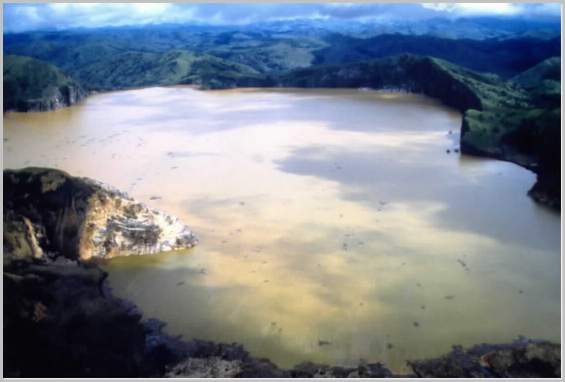The earth rumbles, grumbles, snorts, and regurgitates- it spews hot liquids and poisonous gases. It throws rocks. It tears at land by winds and water by stillness. It is as if the earth is at war with itself. Trapped within this war are the creatures that inhabit the planet. Thinking man can do little about most of these natural events except to observe and marvel. Weather, volcano eruption, and earthquakes happen. These natural phenomenon cannot be controlled or predicted. As human knowledge grows, man devises means to deal with natural events. Some events create greater mystery than others. Limnic eruptions are relatively new phenomenon that has caught the eye of perplexed scientists.

Limnic eruptions have happened twice. Both eruptions occurred in the 1980’s in the west African country of Cameroon. The Lake Monoun eruption in 1984 caused 37 people to die. Two years later Lake Nyos erupted killing more than 1700 people. The deaths were caused by asphyxiation. The shock of such strange occurrences has raised many questions within the scientific community. The main questions stand out: What are these events? What are there causes?
Based on eyewitness accounts and biological testing, scientists have created the following scenario of Limnic eruptions. Carbon dioxide collects at the bottom of a lake over time. Suddenly the bottom of the lake literally explodes releasing a the gas in a gigantic bubble. Associated with the “burp” is a a tsunami-like wave that spreads across the lake. The deaths are associated with oxygen deprivation which is consistent with high levels of carbon dioxide. The people and livestock were literally choked to death.
What is the cause for such rare occurrences? There are many explanations offered. Some claimed that it was due to a chemical warfare attack while others see an alien event. There are those that point to punishment for offending some sinister god. However, the evidence seems to point in another direction. Volcanic eruptions leave indisputable evidence: fire, lava, and billowing clouds of noxious gases and debris. Limnic eruptions leave deaths of human and livestock consistent with asphyxiation and no signs of burns. The lack of volcanic activity of any type is noteworthy. No evidence of earthquake or land movement is reported at the time of the eruptions. Normal claims have to be put aside. The only reasonable explanations then is that a large layer, not a pocket, of carbon dioxide formed and was suddenly released. Carbon dioxide being heavier than air replaces the air at the surface causing the deaths.
This leaves some questions. Where does the carbon dioxide come from? How is it trapped under the lake? What triggers the sudden release of the gas? And are there other lakes in the world that might suddenly overturn? In the past two decades scientists have debated the answers to these questions. Although disagreements remain, there are certain accords .
Science agrees that carbon dioxide levels were very high in the lakes that erupted. It is conceivable that the carbon dioxide trapped in the lake was similar to soda pop in a capped bottle. The carbonation remained dissolved until the cap was opened, that is, the pressure released. Higher quantities of gas dissolve under pressure and in lower temperatures. A large deep lake provide ideal conditions for carbon dioxide gas to have a high saturation level. When the pressure or temperature changes, the carbon dioxide, like shaken soda pop, is released. The sudden release causes more carbon dioxide to be released and soon a reversed funnel is formed. The carbon dioxide bubble explodes to the surface.
The carbon dioxide may be formed at the bottom of a lake as a result of decaying life forms or minor volcanic activity. The carbon dioxide that was formed remained dissolved under the cold temperatures and high pressure of the lake bottom. A slight earthquake or increased volcanic activity would cause a change in the temperature or pressure at the bottom of the lake. This could trigger the eruption. The earthquake or volcanic action would have to be so slight to be undetectable.
Scientists use these ideas to develop a profile of what a lake in danger would exhibit. A suspected lake must be a deep located in an area that is in the proximity of volcanic activity and the lake could be tested with high carbon dioxide levels. Investigations have found only one other lake that fit this description- Lake Kivu. Lake Kivu is located just south of the two previous eruptions. It is located in the Congo Republic near the border with Rwanda. It has become the center for scientific observation and concern.

